This is the first post in a series about Reducing Gun Violence in the United States.
In 2017, there were almost 40,000 firearm-related deaths.
To put this into perspective, this is just slightly more than the number of deaths due to motor vehicle crashes (around 37,000).
In order to really understand the scope of the problem of gun violence in the United States, let’s start by looking at the data itself. It is important to know that the data will not tell us why there is so much gun violence, but it will provide context.
- For those who want to see the highlights without going through the data, skip right to the conclusions at the bottom of this post.
- The data in this post comes from several different sources, which I’ve linked in the references section at the bottom of this post for those who want to see the data for themselves.
Now, let’s dive into how gun violence shows up in the United States.
Firearm violence data
Those roughly 40,000 deaths due to firearms can be broken down into several categories (source CDC Wonder):
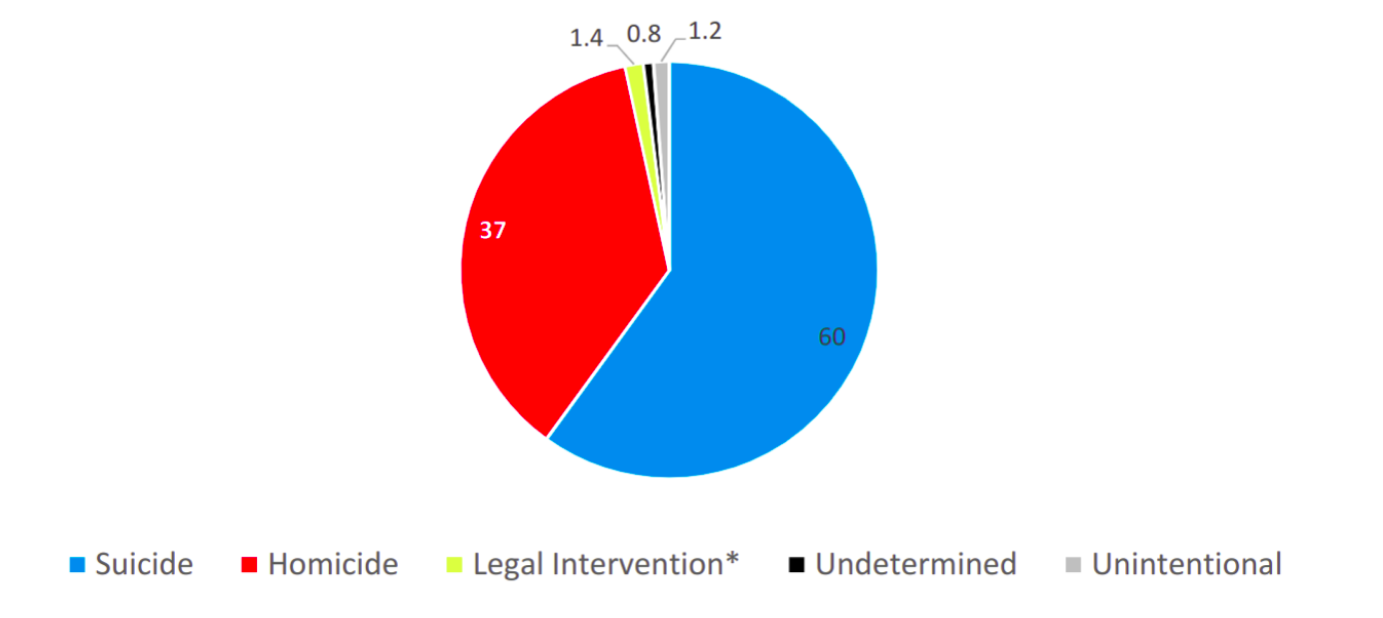
- Suicide: 60% (23,854)
- Homicide: 37% (14,542)
- Legal Intervention (typically due to law enforcement activities): 1.4% (538)
- Unintentional: 1.2% (495)
- Unknown: 0.8% (338)
Slicing this data another way, we can look at the number of people admitted to hospitals with non-fatal gunshot wounds, and how they got there. Note how more than three-quarters of these people were admitted due to assaults (source: CDC Wonder):
- Assault: 76% (88,702)
- Unintentional: 18% (21,219)
- Intentional self-inflicted (failed suicide attempt): 4% (4,357)
- Legal intervention: 2% (2,136)
Let’s take a look at the rate of firearm homicides and suicides overall. The number of suicides due to firearms has been significantly bigger than the number of homicides for almost twenty years, with a big increase in suicides since 2006.
Firearm homicide and suicide rates per 100,000 people in the US, 1999-2017 (source: CDC Wonder)
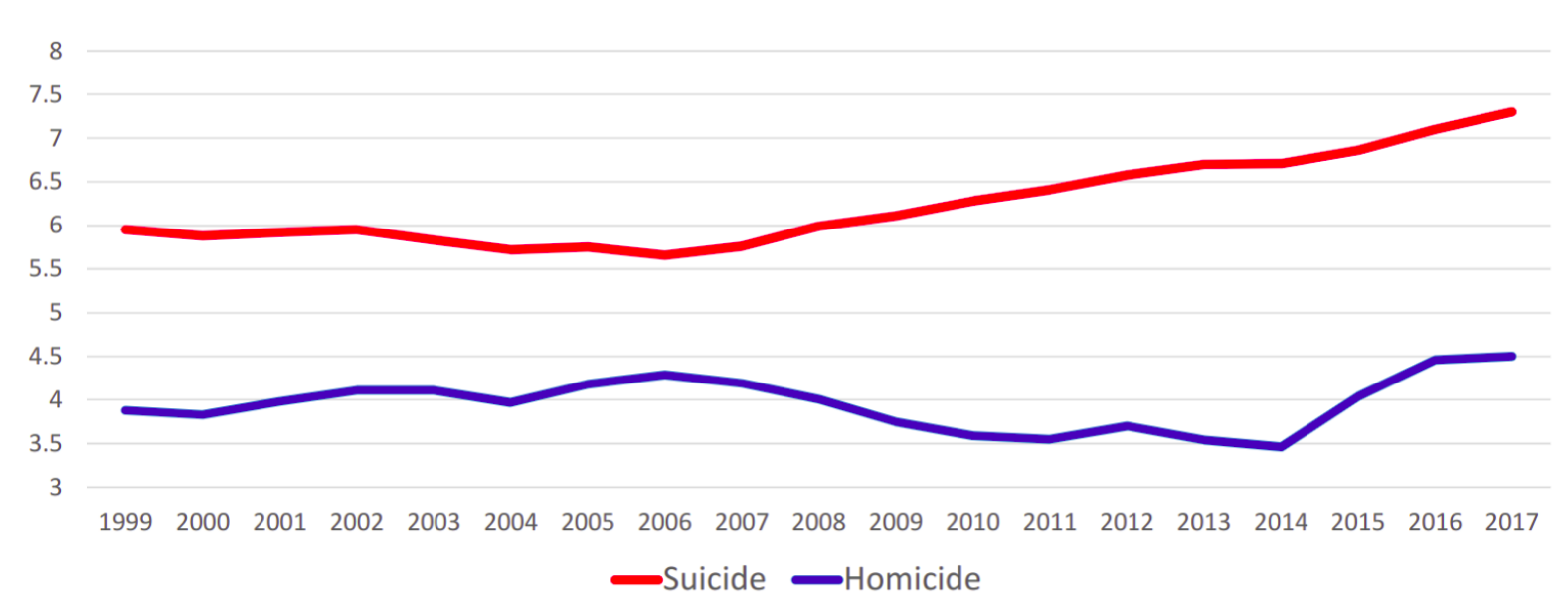
Men have a much greater rate of being involved in firearm violence than women; more than 90% of people killing others with guns are men, and almost 90% of suicide victims are men.
Fractions of firearm homicide and suicide per gender in the US, 2017 (sources: CDC Wonder & FBI Crime in the US)
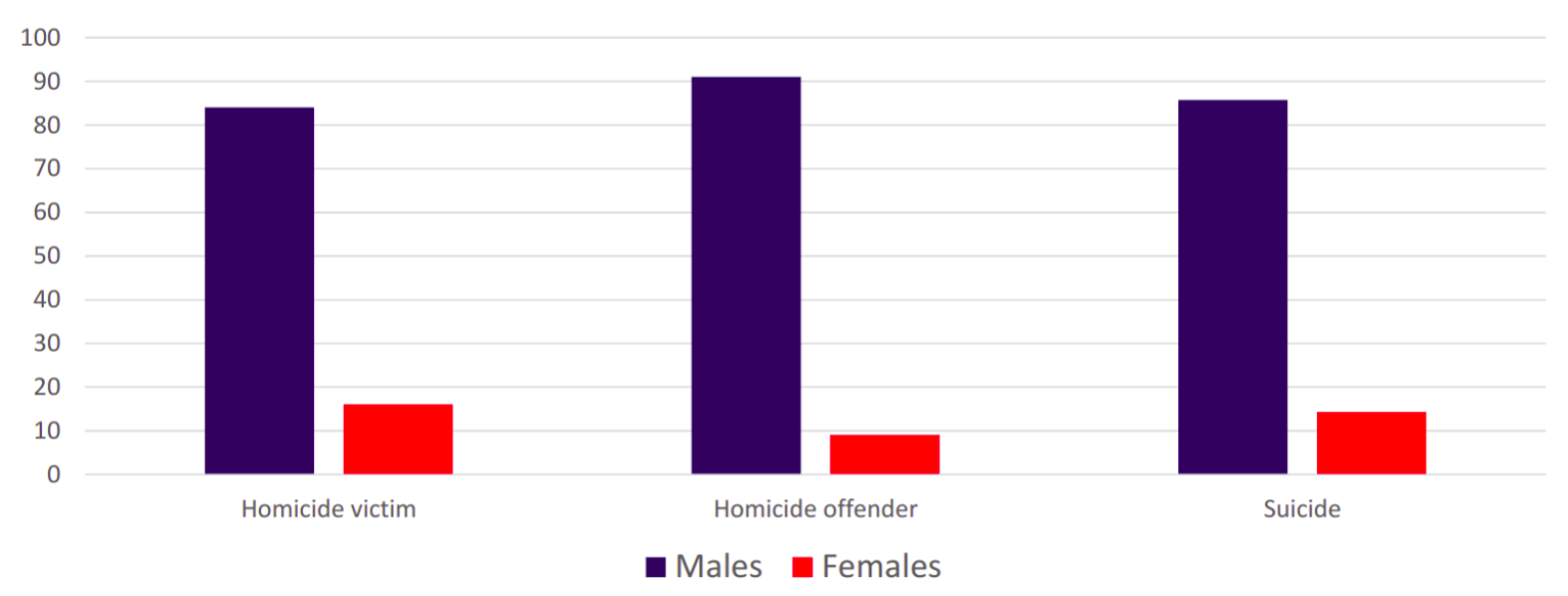
Three of the biggest racial groups that experience firearm violence in the US are whites, blacks, and Native Americans. There is a much larger rate of homicide (both as offenders and victims) among blacks, though the suicide rates are more evenly divided though slightly higher for whites:
Firearm homicide offenders, homicide victims, and suicide victims per race per 100,000 people in the US, 2017 (sources: CDC Wonder & FBI Crime in the US)
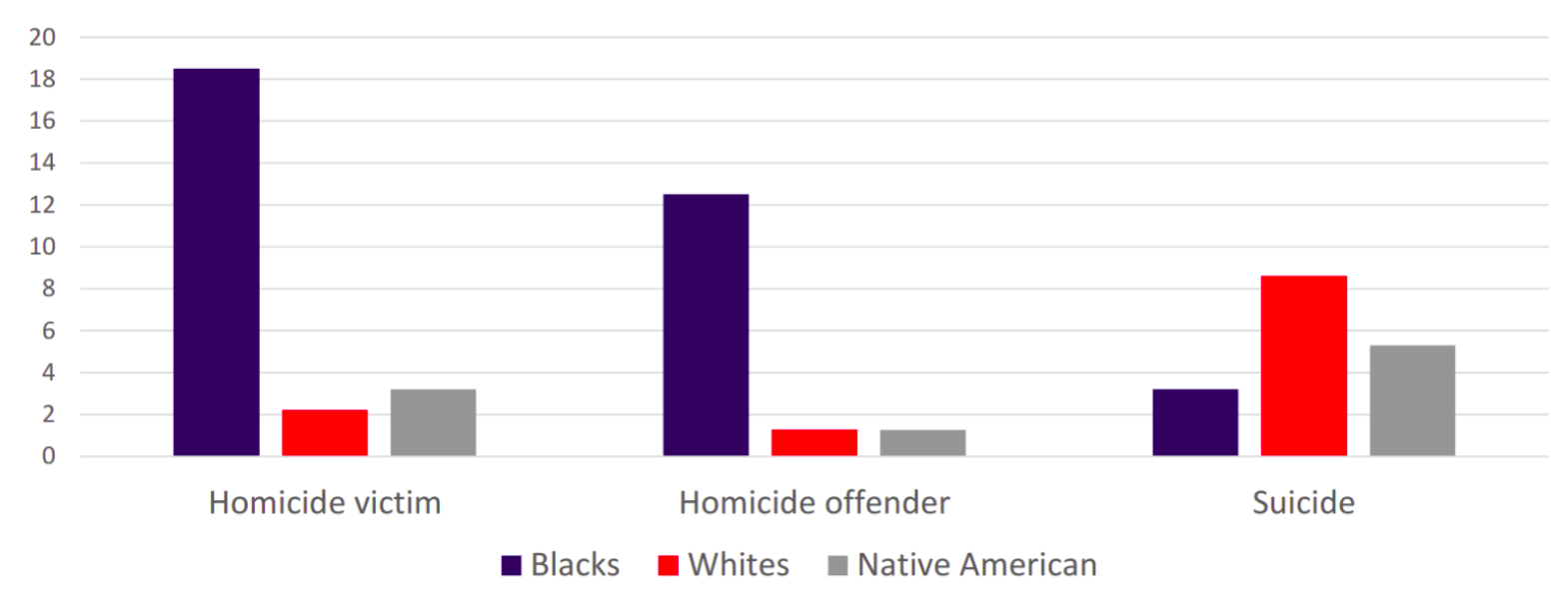
There is a rise in suicide rates as people age:
Ages of suicide victims per 100,000 people in the US, 1999-2017 (sources: CDC Wonder & FBI Crime in the US)
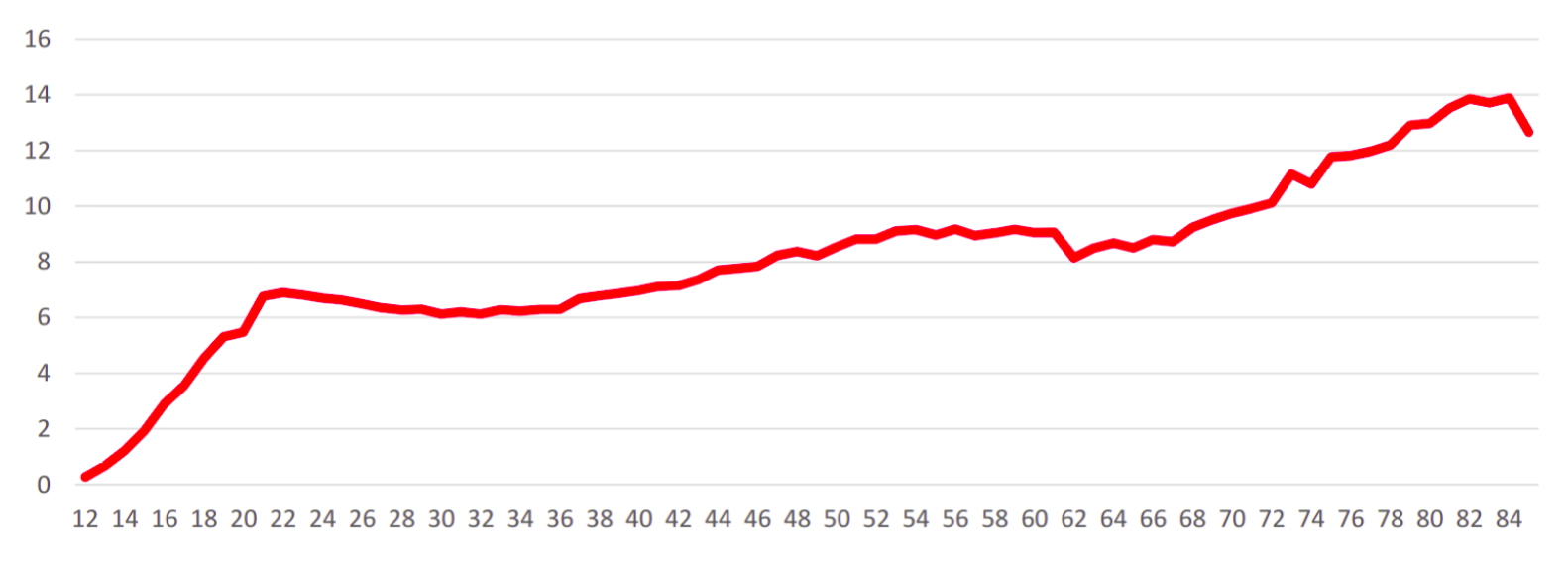
However, the number of Americans involved in homicides by age looks very different. Victims of gun homicide peak around age 21, and those pulling the trigger on those guns also peak around ages 18-20.
Ages of firearm homicide victims per 100,000 people in the US, 1999-2017 (sources: CDC Wonder & FBI Crime in the US)
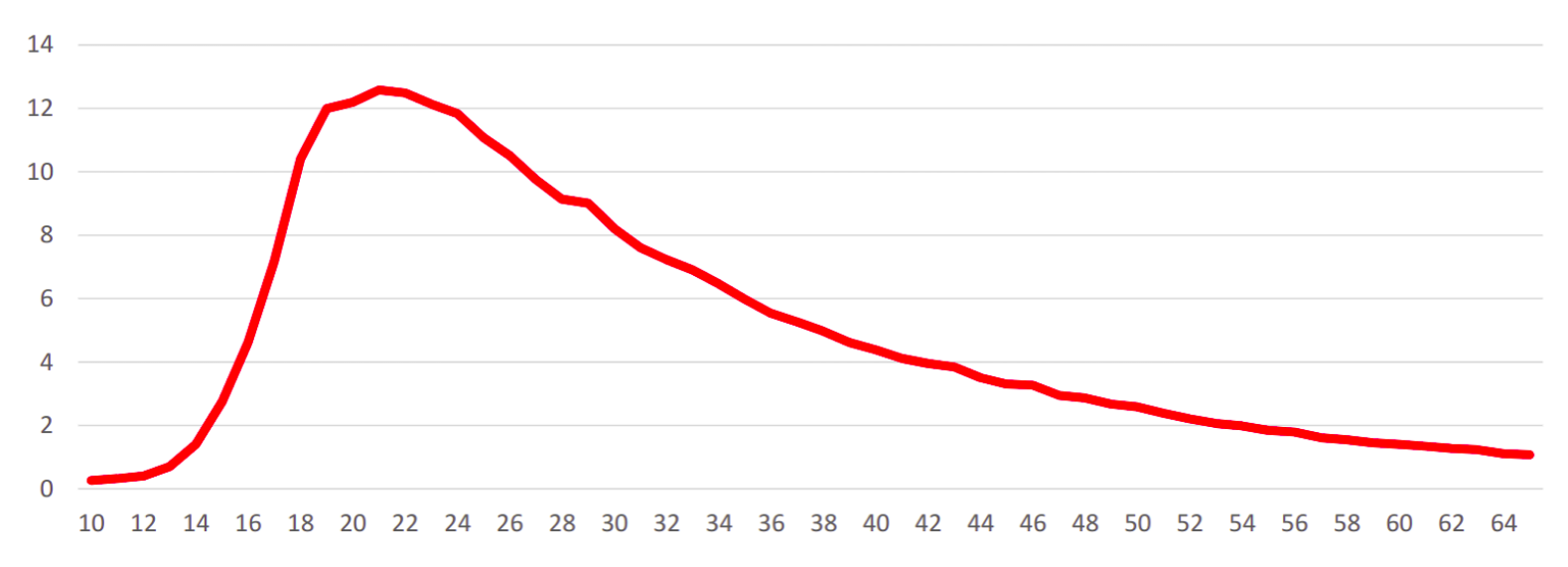
Ages of firearm homicide offenders per 100,000 people in the US, 1999-2017 (sources: CDC Wonder & FBI Crime in the US)
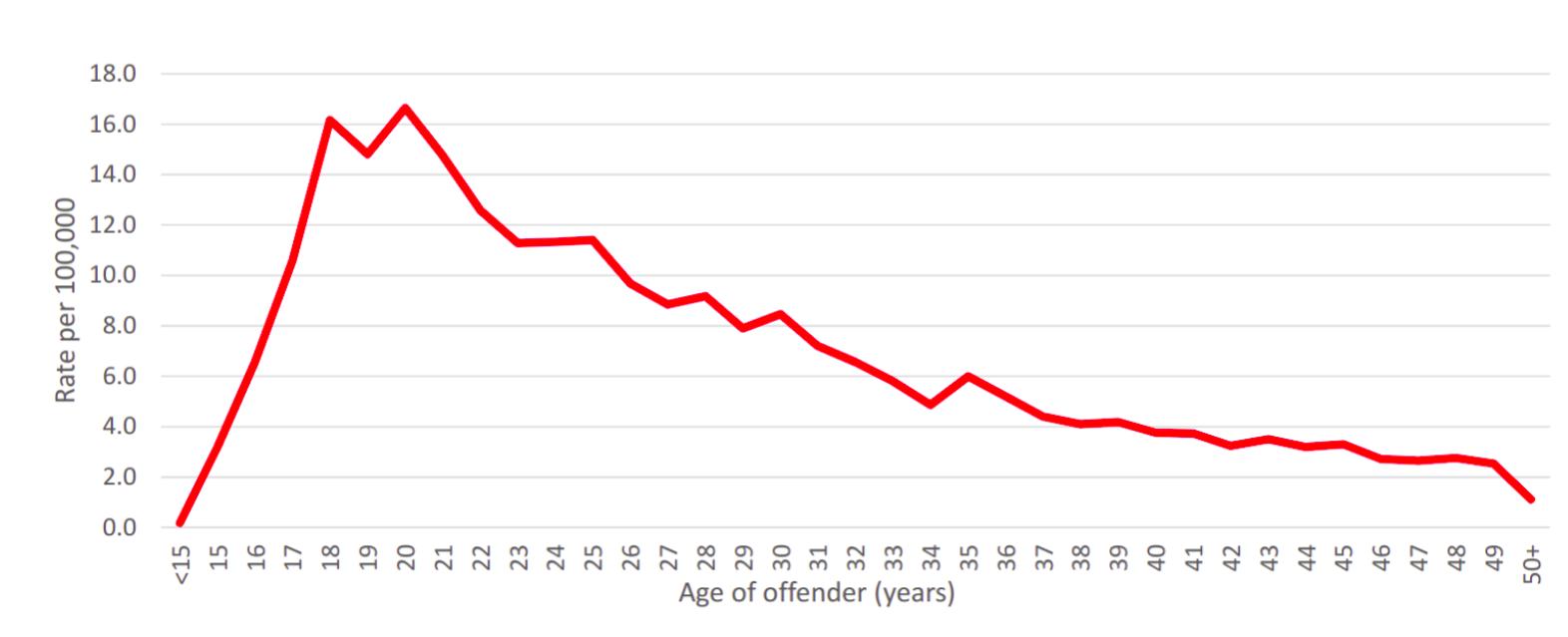
Looking at regional effects, it’s pretty clear that the rate of homicide is greatest in the Southeast and Midwestern states. The states in red have the highest firearm homicide rates, with the states in light green having the lowest firearm homicide rates:
Firearm homicide rates per state (sources: CDC NHSS and US Census)
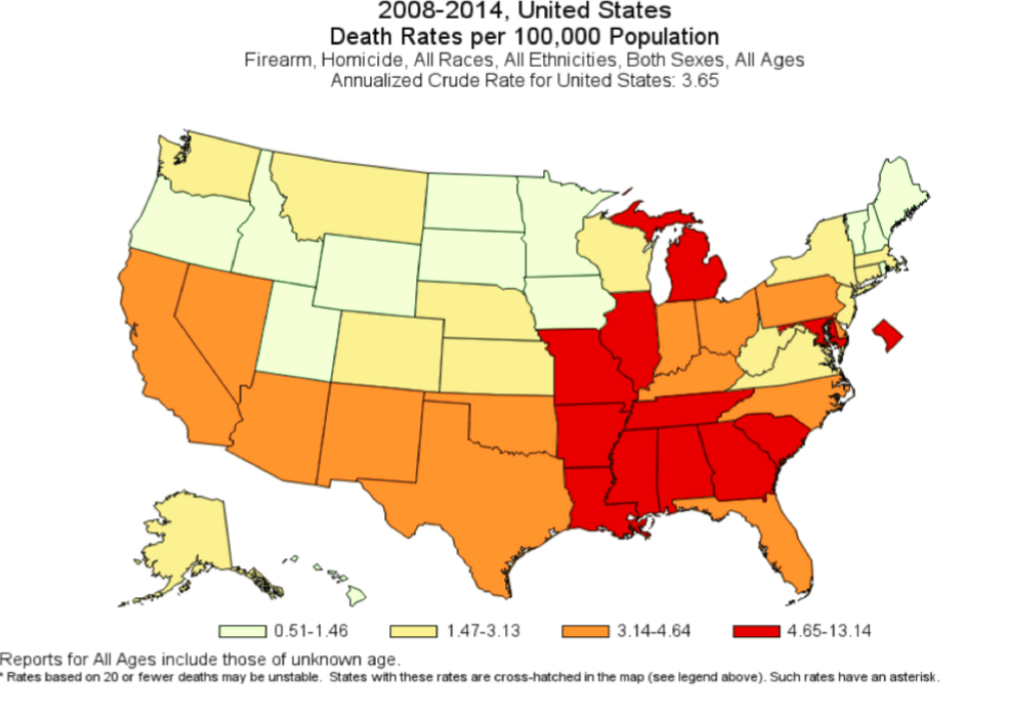
And, if we look at firearm suicides, some of the Northern Plains states have the highest rates, likewise with some other states in the interior:
Firearm suicide rates per state (sources: CDC NHSS and US Census)
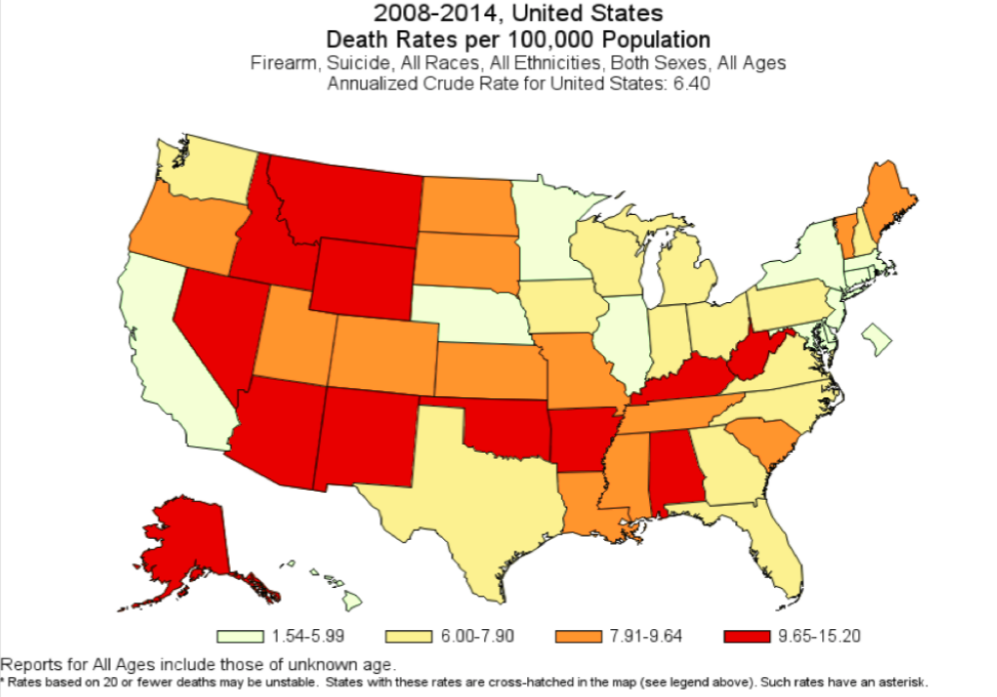
The highest rates of firearm suicide tend to be in rural and non-metro areas. Firearm homicides are generally highest in large metro areas, but then don’t shrink as dramatically in rural areas as some people would expect:
Firearm homicide and suicide rates per area, 2017 (sources: CDC NHSS and US Census)
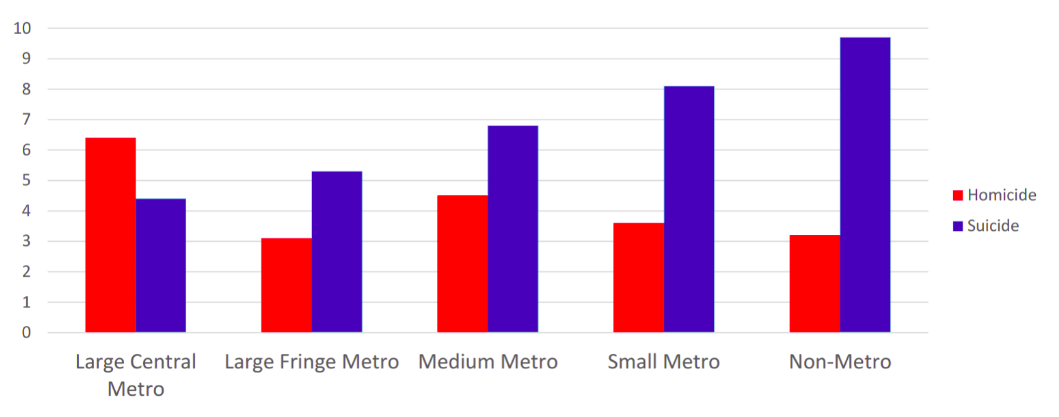
Gun Ownership
Let’s now look at data related to gun ownership.
About four in ten US adults say that they live in a house with a gun (source Pew research):
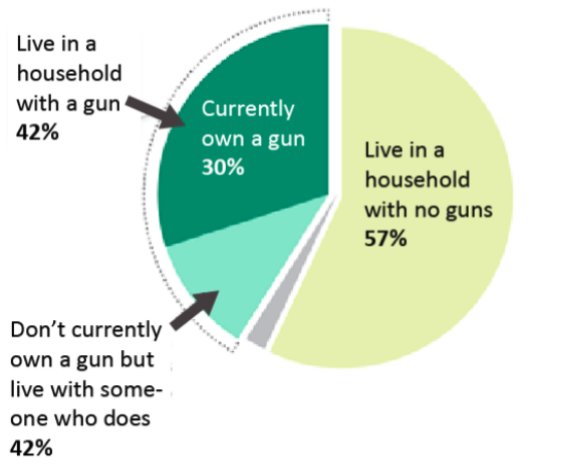
Who are these gun owners?
Breaking down owners among gender and race, it’s more common for whites and men to own guns (source Pew research):
- 39% of men
- 22% of women
- 36% of whites
- 24% of blacks
- 15% of hispanics
White men report that almost half of them (48%) own a gun, and the average age for an American to become a gun owner is at age 22.
Let’s look at the educational level of gun owners. The educational level differs significantly only among whites (source Pew research):
- 40% have a high-school diploma or less
- 42% have completed some college
- 26% have a bachelors degree or higher
We can also look at political affiliation: twice as many people who identify as republicans own guns as those who identify as democrats (source Pew research).
Where do gun owners live?
Looking at where gun owners live (source Pew research):
- 46% of rural residents own a gun
- 28% of suburban residents own a gun
- 18% of urban residents own a gun
How about geographical concentration? (source Pew research):
- 18% of residents in the Northeast of the country own a gun
- 36% of residents in the South own a gun
- 32% of residents in the Midwest own a gun
- 31% of residents in the West own a gun
Why do people own a gun, and what kinds do they own?
People give different reasons for owning a gun, and most people give multiple reasons (source Pew research):
- 67% gun owners cite self-defense
- 38% gun owners cite hunting
- 30% gun owners cite sport shooting
Similar numbers appear for the types of guns that people own (source Pew research):
- 62% of gun owners own a handgun or pistol
- 22% of gun owners own a rifle
- 16% of gun owners own a shotgun
How many guns do gun owners own? Two-thirds of gun owners own multiple guns, and 29% of gun owners own five or more guns (source Pew research).
Gun ownership over time
Gun ownership over time has been gradually decreasing. The following chart shows the percentage of people in the US who own at least one gun (source NORC GSS):
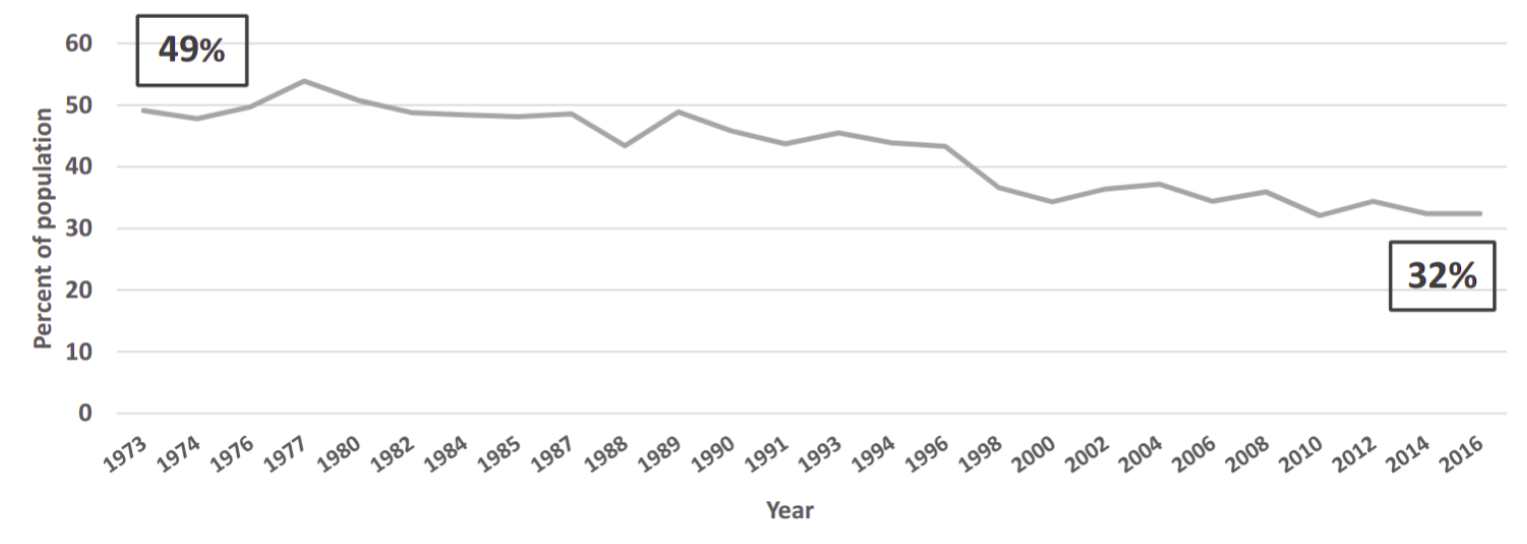
Though the number of people who own handguns or pistols fluctuates without a clear pattern (source NORC GSS):
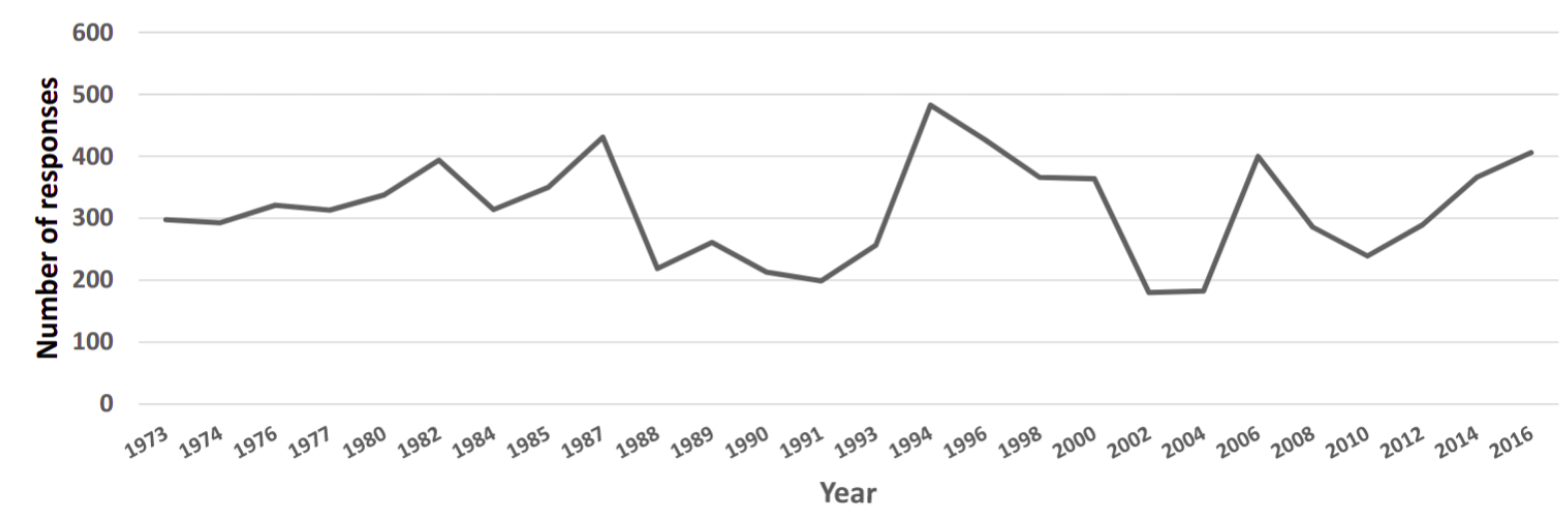
Defensive gun use, Gun Access, and Public Safety
Incidents of gun violence are spread across the United States (source: Gun Violence Archive):
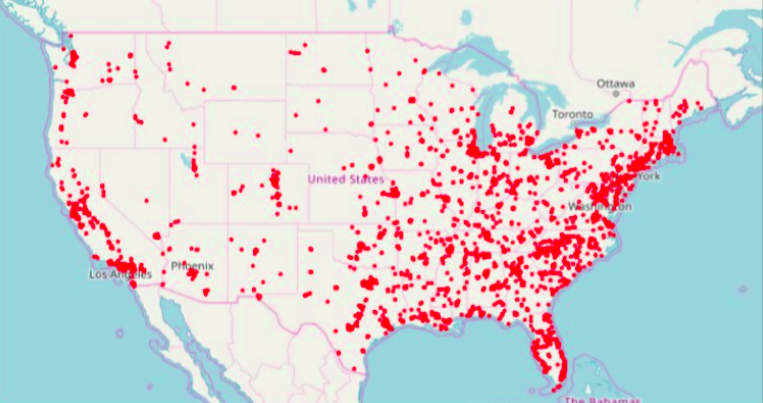
… while reports of guns used in self-defense are relatively small, and they’re generally located in southern states where gun ownership is more common (source: Gun Violence Archive):
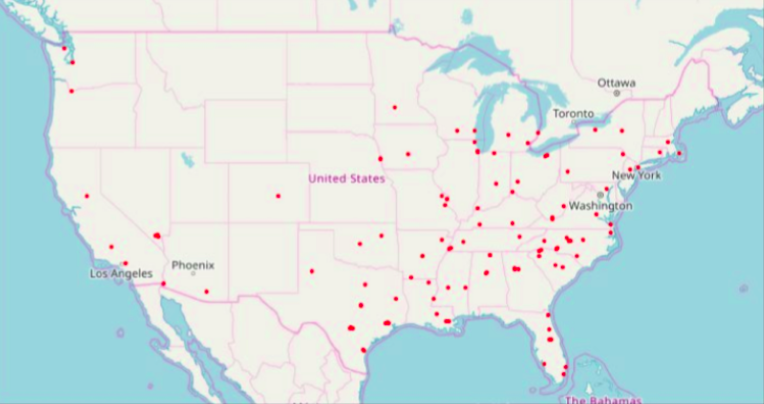
This data is confirmed by Pew Research, which finds that guns are used for self-defense in less than 1% of crimes. This is contrasting with data saying that 67% of gun owners own guns for self-defense.
Another two particularly interesting data points to note are:
- 4% of people using guns in self-defense actually injured themselves
- 4% of people not using guns in self-defense also injured themselves
… meaning that there isn’t a benefit to using a gun in self-defense, statistically – you’re just as likely to get hurt as if you didn’t use a gun.
What’s the legality of using a gun in self-defense?
Only 43% of the self-reported use of guns in self-defense are actually deemed to be legal by criminal court judges. In other words, most people who report using guns for self-defense aren’t legally allowed to do what they did. (source: Gun Use in the US)
Certainly, some use of self-defense is legally justifiable, just not all of it.
What about anger and impulsivity?
9% of US adults (4 million people) have a history of angry and impulsive behavior and have access to firearms in their home.
Those adults who own six or more guns are four times more likely to carry a gun and show angry and impulsive behavior than those who own just one gun (source: Anger / Impulsive)
Conclusions
Firearm Violence Impact
- 40,000 people a year die from firearm violence
- 60% – almost 24,000 – are suicides
- almost 40% – about 14,000 – are homicides
- Suicide rates have been steadily increasing since 2006
- Men are nine times as likely to be involved in homicide or suicide as women
- Suicide risk rises with age
- Homicide risk (both being an offender and victim) peaks around age 20
- Northern plains and some Southern states have the highest rates of suicide
- Higher rates in rural and non-urban areas
- Southern and Midwestern states have the highest rates of homicide
- No strong relationship between homicide rates and population density (urban vs rural)
Gun Ownership
- Four out of ten US adults live in a home with a gun
- The most common group of people who identify themselves as gun owners are white men who have not completed college, live in rural areas, and are republicans
- The majority of gun owners own handguns for self-defense
- Gun ownership has been decreasing over time to 32% of the population
Defensive gun use
- Guns are used in self-defense for less than 1% of crimes
- And 4% of those times, the person using the gun for self-defense hurts themselves
- That’s the same fraction of people that hurt themselves in self-defense without a gun
- Most people who use guns for self-defense do so in a way that courts view as illegal
- 9% of US adults own a gun and have a history of angry and impulsive behavior
- Adults who own six or more guns are four times more likely to carry a gun in public and show angry and impulsive behavior than those who just own one gun
Next up: Gun Markets, Ownership, and Violence Risk
References
- CDC Wonder – a public resource of health-related datasets for CDC staff, public health departments, researchers, and the general public. The year 2017 is the most recent year for which comprehensive, compiled data exists for firearm violence
- FBI Crime in the US 2017 – a statistical compilation of offense, arrest, and police employee data reported by law enforcement agencies voluntarily participating in the FBI’s Uniform Crime Reporting (UCR) Program
- CDC National Vital Statistics System (NVSS) – a public resource for official vital statistics
- US Census Bureau – providing aggregate data for public use
- Pew Research – published “America’s Complex Relationship With Guns”
- National Opinion Research Center’s General Social Survey (NORC GSS) – a public report for policymakers and scholars to give an unbiased and clear perspective on what Americans think about general social topics
- Gun Violence Archive – a free 2019 dataset providing public access to accurate information about gun-related violence in the United States
- Gun use in the United States – a survey of guns used in self-defense and evaluation by criminal judges
- Anger / Impulsive – a national report on the co‐occurrence of impulsive angry behavior and possessing or carrying a gun among adults